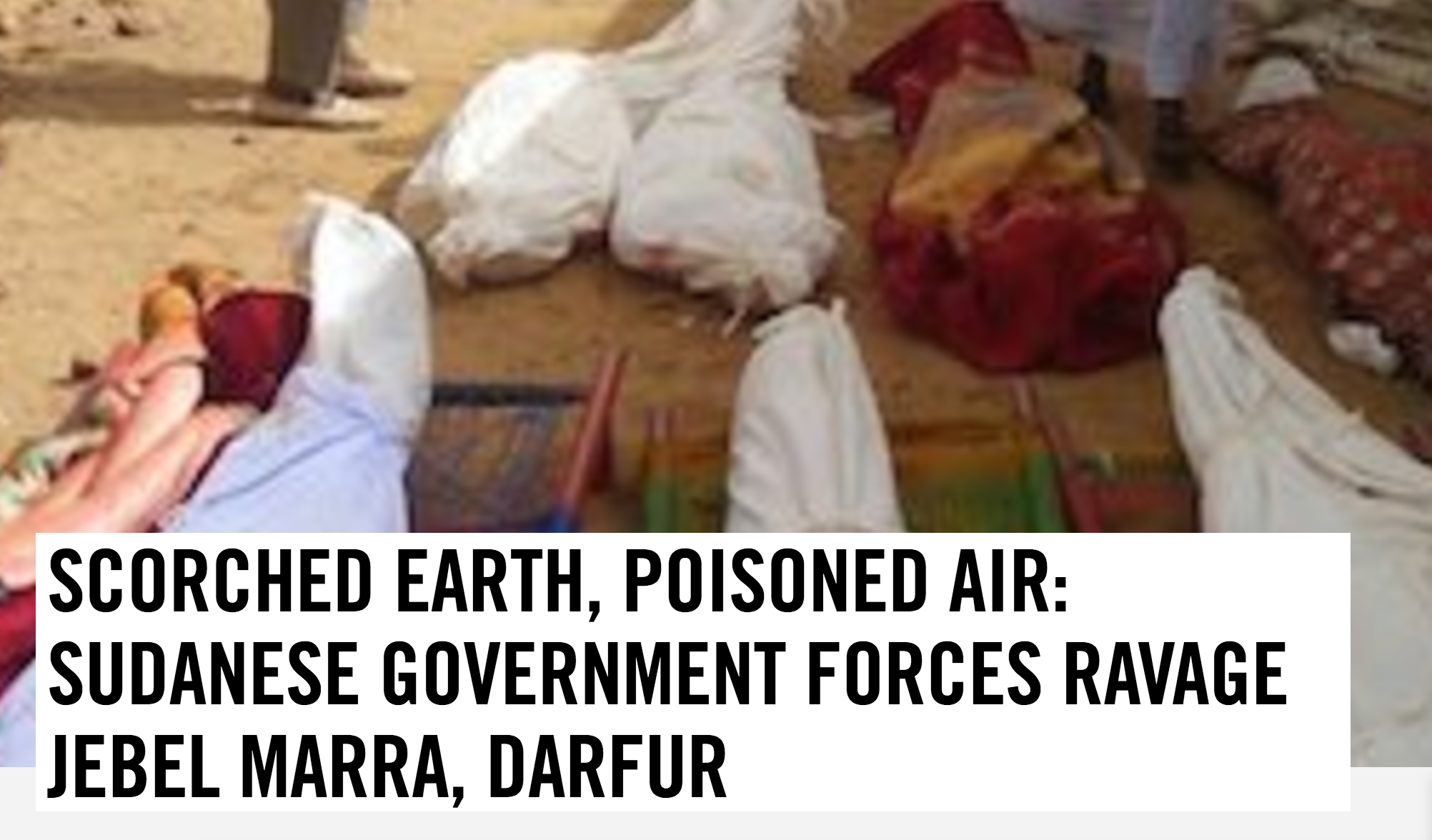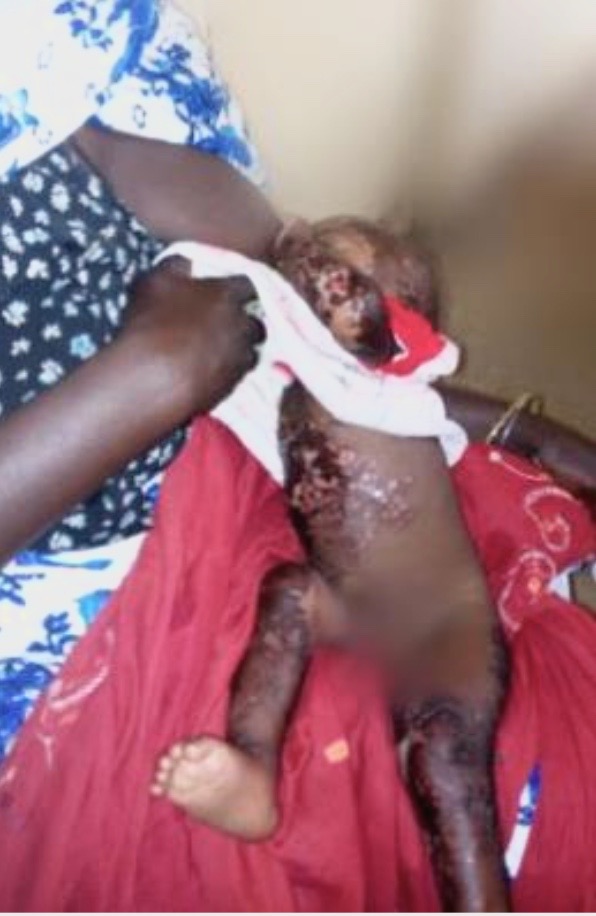Chemical Weapons Use and Hypocrisy: Syria and Sudan
Eric Reeves | April 8, 2018 | https://wp.me/p45rOG-2ew
Non-Arab/African civilians in Darfur killed by chemical weapons in 2016 weren’t even a flicker in the eye of international news attention; the evidence of chemical weapons use provided in 2016 by Amnesty International was simply overwhelming. By contrast, such assaults in Syria are instantly headlines, as witnessed by the reporting below:
• Dozens Suffocate in Syria as Government Is Accused of Chemical Attack | New York Times, APRIL 8, 2017
• Dozens killed in apparent chemical weapons attack on civilians in Syria, rescue workers say, Washington Post, ISTANBUL April 8, 2018
• Pope Francis condemns the use of chemical weapons in Syria, The Guardian, April 8, 2018
• Syria war: At least 70 killed in suspected chemical attack in Douma, BBC, April 8, 2018
Also reporting on the latest reported chemical weapons attack in Syria:
• Associated Press
• Reuters
• Agence France-Presse
• Financial Times
• CNN
• CBS New
… and many others.
• Only Russia, where there is no independent news, dissents: “Russia says Syria gas attack reports ‘fabricated,’” Reuters April 8, 2018
The Assad regime in Syria is an international pariah, in part because of its continued use of chemical weapons attacks, such as that reported to have occurred recently. The regime of Omar al-Bashir and his fellow génocidaires, by contrast, is the object of continuing rapprochement by Western nations in Europe and North America, and elsewhere as well.
The evidence of chemical weapons use provided in 2016 by Amnesty International is overwhelming. It is difficult to escape the conclusion that non-Arab/African lives in Darfur are suffering from a shocking moral discounting–and invisibility–the source of which is a ghastly combination of narrow self-interest and racism. The hypocrisy is beyond reckoning…or forgiving.
***************************
“Scorched Earth, Poisoned Air: Sudanese Government Forces Ravage Jebel Marra, Darfur,” Amnesty International | 109 pages; released September 29, 2016
Using satellite imagery, more than 200 in-depth interviews with survivors and expert analysis of dozens of appalling images showing babies and young children with terrible injuries, the investigation indicates that at least 30 likely chemical attacks have taken place in the Jebel Marra area of Darfur since January 2016. The most recent was on September 9 [2016].
“The scale and brutality of these attacks is hard to put into words. The images and videos we have seen in the course of our research are truly shocking; in one a young child is screaming with pain before dying; many photos show young children covered in lesions and blisters. Some were unable to breathe and vomiting blood,” said Tirana Hassan, Amnesty International’s Director of Crisis Research.
[No known human pathogen or environmental hazard can produce such injuries as seen below, in the circumstances described by the victims and witnesses, and given the terrain of the Jebel Marra massif in Central Darfur. And yet the Organization for the Prohibition of Chemical Weapons (OPCW), charged with investigating chemical weapons use, has done nothing to confirm the findings of Amnesty International. The Khartoum regime holds the position of Vice Chair of the Executive Committee of OPCW, which tells us all we need to know about the integrity of the organization—ER]
From pages 69 – 70 of the Amnesty Report:
The chemical weapons agents were reportedly delivered by both bombs and by rockets. A majority of survivors of alleged chemical weapons attacks reported that the chemical weapons agents were discharged from a bomb dropped from an Antonov airplane. A minority reported that they were released from rockets fired from the ground. Four survivors said that they witnessed the alleged chemical weapons agents being discharged from both bombs and rockets. Many of the survivors told Amnesty International that the bombs which delivered the alleged chemical weapons agents exploded upon contact with the ground and subsequently released a thick cloud of smoke.
Many of the survivors reported that the bomb which delivered the alleged chemical weapons agents exploded in mid-air, that the explosion was usually preceded by a bright flame or a flash of light, and that after the bomb exploded, it released a cloud of smoke or dust which proceeded to spread out over a large area and descend towards the ground. Several survivors reported that they had witnessed the alleged chemical weapons agents being released from both types of bombs during different attacks.
from page 70 of the Amnesty report:
Many survivors reported that the alleged chemical weapons agents that were released from bombs left a thick coat of black dust on the ground, trees, grass, and human beings in the vicinity.
Every survivor said that the smoke smelled noxious. Many were unable to articulate the smell beyond the fact that they found it intensely disagreeable; witnesses often said that they had never experienced anything like it before or that it was “unnatural.” Several survivors described that smell as putrid or musty. Several described is as “rotten”, “like rotten eggs”, “hot”, or “hot like pepper”, or some combination thereof. Four survivors described the smell as similar to an insecticide or chlorine or sulphide.
Several survivors reported seeing the colour of water in wadis change after bombs containing the alleged chemical weapons landed in the wadi.
Several survivors said that large numbers of birds and other animals, including donkeys, died after coming into contact with the alleged chemical weapons agents.
from page 70 of the Amnesty report:
Caregivers frequently observed changes to the victims’ eyes, including changes to eye colour, bulging eyes, constant discharge of liquid from the eyes, constant itchiness, spots under the eyelids, and a reduction in vision. Several survivors lost their vision.
Survivors and caregivers reported a variety of respiratory problems that occurred shortly after exposure to the alleged chemical weapons agents, including severe coughing, difficulty breathing, and lung infections. Suffocation was among the most common causes of death for victims of the alleged chemical weapons attacks.
Miscarriages among those exposed were commonly reported by witnesses and caregivers; hundreds of miscarriages were reported, which were often much bloodier than normal. The miscarriages reportedly occurred either on the same day or within a few days of the exposure to the alleged chemical weapons agent.
Survivors and caregivers reported dramatic changes to the smell of the breath of people exposed to the suspected chemical weapons agents. The smell of the breath was always reported to be extraordinarily disagreeable and often characterized as unnatural.
Many more such photographs can be found at:
https://www.amnestyusa.org/wp-
—
Eric Reeves, Senior Fellow at Harvard University’s François-Xavier Bagnoud Center for Health and Human Rights
Twitter@SudanReeves
About Eric Reeves: http://sudanreeves.org/about-eric-reeves
Philanthropy: https://www.artfulhome.com/navigate?searchTerm=eric+reeves+woodturner


